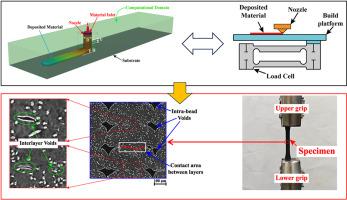了解打印压力对3D打印热塑性复合材料机械性能的影响:建模和实验
IF 9.8
1区 材料科学
Q1 MATERIALS SCIENCE, COMPOSITES
引用次数: 0
摘要
打印压力是一个关键的工艺参数,它对3d打印的纤维增强热塑性复合材料的层间附着力产生重大影响,从而决定了其力学性能。在这项研究中,建立了一个非等温计算流体动力学(CFD)模型,该模型纳入了熔融热塑性材料在熔融长丝制造过程中的非牛顿流变行为。通过集成在构建平台中的高精度力监测系统对打印力的实时测量,CFD模拟在预测打印压力分布方面显示出了显著的准确性。定量分析表明,打印压力的产生主要受两种机制的控制:(i)喷嘴头对新挤出的热塑性材料产生的压缩力,以及(ii)熔融热塑性塑料沉积在构建平台或先前沉积层上的减速所产生的冲击力。此外,CFD模型能够建立打印质量和打印压力之间的相关性。详细的机理分析,阐明了层间附着力不足的根本原因,相对于各种印刷参数。实验结果表明,优化后的印刷压力可以有效地消除丝内空隙,同时增加相邻层之间的界面接触面积,从而显著提高印刷复合材料结构的层间粘附强度。本文章由计算机程序翻译,如有差异,请以英文原文为准。

Understanding printing pressure on the mechanical performances of 3D printed thermoplastic composites: modelling and experiments
Printing pressure represents a critical processing parameter that exerts substantial influence on the interlayer adhesion of 3D-printed fiber-reinforced thermoplastic composites, consequently determining their mechanical performance. In this investigation, a non-isothermal computational fluid dynamics (CFD) model was developed, incorporating the non-Newtonian rheological behavior of molten thermoplastic materials during the fused filament fabrication process. The CFD simulations demonstrated remarkable accuracy in predicting printing pressure distributions, which were validated through real-time measurements of printing forces using a high-precision force monitoring system integrated into the build platform. Quantitative analysis revealed that the generation of printing pressure is predominantly governed by two mechanisms: (i) the compressive forces induced by the nozzle head on newly extruded thermoplastic materials, and (ii) the impact forces resulting from the deceleration of molten thermoplastic deposition onto the build platform or previously deposited layers. Furthermore, the CFD model enabled the establishment of a correlation between print quality and printing pressure. Detailed mechanistic analysis was conducted to elucidate the fundamental causes of inadequate interlayer adhesion with respect to various printing parameters. The experimental results conclusively demonstrated that optimized printing pressures effectively eliminate intra-filament voids while simultaneously increasing the interfacial contact area between adjacent layers, thereby significantly enhancing the interlayer adhesion strength in printed composite structures.
求助全文
通过发布文献求助,成功后即可免费获取论文全文。
去求助
来源期刊

Composites Science and Technology
工程技术-材料科学:复合
CiteScore
16.20
自引率
9.90%
发文量
611
审稿时长
33 days
期刊介绍:
Composites Science and Technology publishes refereed original articles on the fundamental and applied science of engineering composites. The focus of this journal is on polymeric matrix composites with reinforcements/fillers ranging from nano- to macro-scale. CSTE encourages manuscripts reporting unique, innovative contributions to the physics, chemistry, materials science and applied mechanics aspects of advanced composites.
Besides traditional fiber reinforced composites, novel composites with significant potential for engineering applications are encouraged.
 求助内容:
求助内容: 应助结果提醒方式:
应助结果提醒方式:


